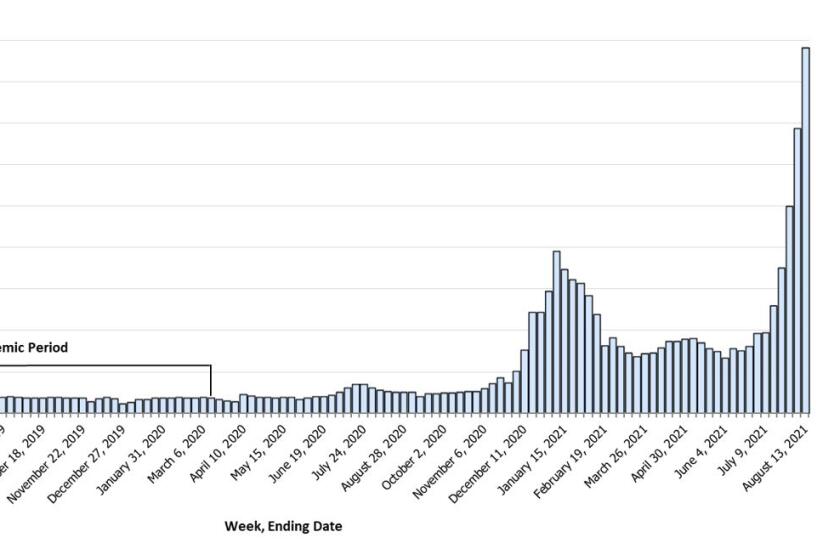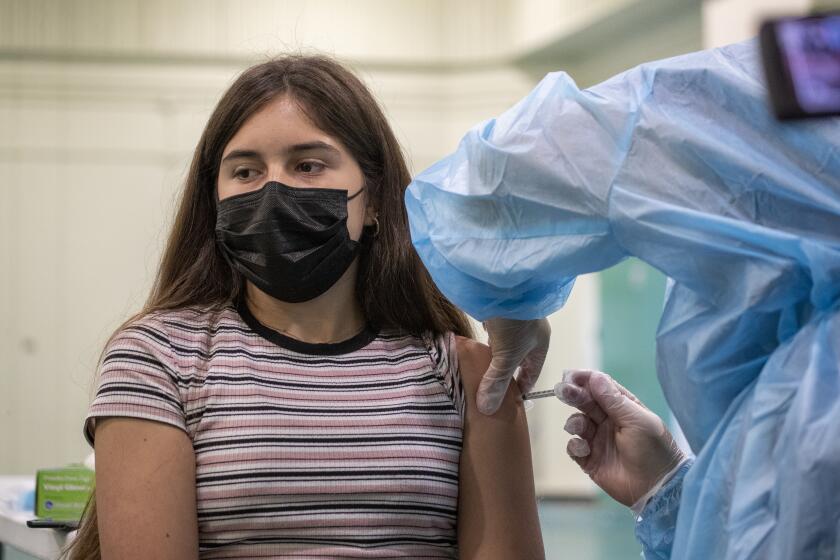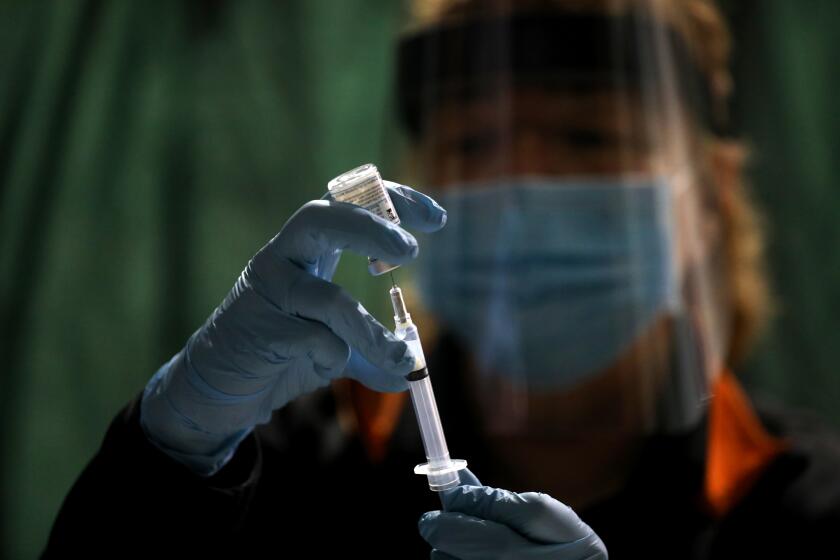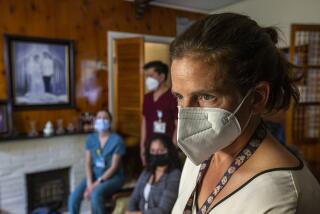‘Momentous occasion’ as 80% statewide have gotten at least one vaccine dose
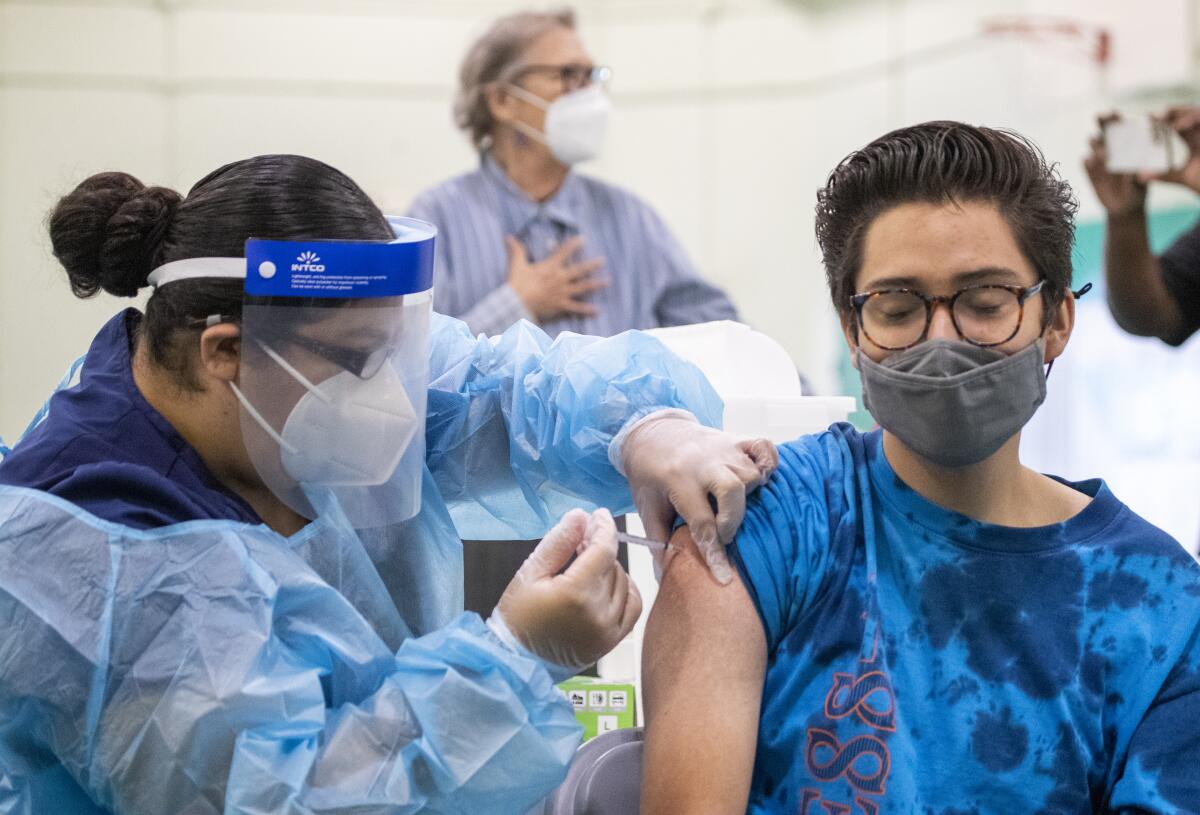
- Share via
More than 80% of eligible Californians have now received at least one dose of COVID-19 vaccine, a milestone Gov. Gavin Newsom characterized as a “momentous occasion” that nevertheless underscored that more needed to be done.
That level of vaccine coverage among residents 12 and older ranks ninth out of all states, according to data from the U.S. Centers for Disease Control and Prevention.
California’s partial-inoculation share of 80.6% outpaces the rates in Pennsylvania, at 80%; New York, 78%; Florida, 73.1%; and Texas, 68.6%, federal figures show. States with even higher rates are mostly in New England, as well as Hawaii and New Mexico.
“Thank you to the people in the state of California for being mindful that this pandemic is not behind us, that, as we battle this Delta variant, this mutation ... we still have work to do,” Newsom said during a briefing Tuesday.
Despite warnings about ivermectin, pharmacies by early August were dispensing more than 88,000 prescriptions a week, the CDC said.
For starters, the share of eligible Californians who are fully vaccinated — meaning they’ve either received the single-shot Johnson & Johnson vaccine or two doses of either Pfizer-BioNTech or Moderna — is smaller, at about 65%.
And sizable gaps persist. Only about half of Black and Latino Californians are at least partially vaccinated, compared with 61% of white residents, 63% of Native Americans and 75% of Asian or Pacific Islander residents, according to data compiled by The Times. (These numbers are an undercount. The race of about 15.3% of people who have been vaccinated is unknown.)
There are also wide geographic disparities. Eleven of California’s 58 counties have at least partially vaccinated more than 70% of their residents, but 16 other counties have seen less than half of their residents roll up their sleeves.
Counties in the Bay Area have California’s highest vaccination rates. Both San Francisco and Santa Clara County, the Bay Area’s most populous, are reporting that 87% of people ages 12 and up have received at least one dose; in Alameda County, the region’s second most populous county, 88% have received at least one dose.
Los Angeles County lags the statewide vaccination rate. In L.A. County, 74% of residents age 12 and older have received at least one vaccination dose.
Apart from union proposal, students will now receive live online instruction when forced into quarantine, ending weeks of mixed signals, confusion and uncertainty.
Weekly COVID-19 vaccinations statewide are up 53% from a low point in mid-July. For the seven-day period that ended Saturday, at least 627,000 vaccination doses were administered, up from a summertime low of about 411,000 doses for the weekly period that ended July 9.
Despite that progress, Newsom said the state was working on “more culturally competent outreach to meet people, quite literally, where they are” and “doing more to try to do better, including in our rural parts and remote parts of the state where we still have a substantial amount of population that need to get these lifesaving vaccines.”
The latest vaccination milestone comes amid continuing signs that the latest coronavirus wave may be starting to level off.
Over the seven-day period ending Tuesday morning, California has reported an average of 12,861 new coronavirus cases per day, according to data compiled by The Times. That’s a roughly 11% decrease from a week ago.
The state also has seen a steady drop in its test positivity rate, which reflects how many tests result in confirmed coronavirus infections.
As of Tuesday, California’s seven-day positivity rate was 4.6%, down from 5.8% two weeks ago.
“I don’t think it’s any surprise that we have among the lowest positivity rates in America, as we have the highest vaccination rates in America,” Newsom said, although he added there was more work to do to increase vaccinations in populations with lower rates, such as among Black and Latino Californians.
By contrast, the nation’s second most populous state, Texas, has a test positivity rate of 16%, according to Johns Hopkins University.
Public health officials say that metric is a telling measure of coronavirus spread. Although the raw number of cases fluctuates depending on how much testing is going on — and testing has ramped up dramatically since California schools opened their doors for the new term — a stable or declining positivity rate can illustrate slowing transmission.
The current caseload, however, is still troublingly high. As of June 15, when California reopened its economy and lifted virtually all coronavirus-related restrictions on businesses and public spaces, the state was recording fewer than 900 total cases per day, on average.
Hospitals remain under stress, although hospitalizations have plateaued recently.
Statewide, 8,342 COVID-19 patients were hospitalized on Monday. That’s up just 1% from the previous week, a big improvement from the previous week-over-week increase, which was 11%.
California’s intensive care units, however, are still seeing a modest increase in COVID-19 patients, Newsom said. On Monday, 2,128 COVID-19 patients were receiving that level of specialized medical attention statewide, a number not seen since mid-February.
Although state figures show roughly 1,700 ICU beds remain available, those are not distributed evenly throughout California. More remote, rural areas might only have access to a handful of ICU beds to begin with, and every one that’s filled by a COVID-19 patient is one less that’s available should someone suffer a serious heart attack or be gravely injured in a car crash.
In August, nine Northern California counties saw more patients hospitalized with COVID-19 than at any other point in the pandemic: Amador, Del Norte, Humboldt, Lake, Mendocino, Placer, Plumas, Shasta and Tuolumne.
“This has been our worst fear,” state Sen. Mike McGuire (D-Healdsburg), who represents seven counties stretching from Marin to Del Norte, previously told The Times. “We saw significant surges in urban areas in this state early on. Now, rural California is the epicenter for this pandemic.”
A group of doctors in Mendocino County, in an open letter, pleaded for people to get vaccinated.
“Never before have we seen such a surge of sick, young patients with COVID-19, and never before has our medical system faced such a challenge. We can all do our part in this dire situation by getting vaccinated,” the doctors wrote.
“Our emergency departments are overflowing. Our hospitals are full. Our ICUs are full. We struggle to find hospital beds even for the patients who are coming to the emergency department with strokes, heart attacks, or appendicitis,” they wrote.
Rural Del Norte County has more people hospitalized with COVID-19 than at any other point in the pandemic. Its only hospital is overwhelmed.
Fatalities, the final repercussion of increases in coronavirus transmission, have also risen sharply recently. Over the weeklong period ending Tuesday morning, an average of 89 people statewide died from COVID-19 each day — roughly double the number two weeks ago.
The pandemic has now killed more than 65,200 Californians.
Times staff writer Hailey Branson-Potts contributed to this report.
More to Read
Sign up for Essential California
The most important California stories and recommendations in your inbox every morning.
You may occasionally receive promotional content from the Los Angeles Times.
